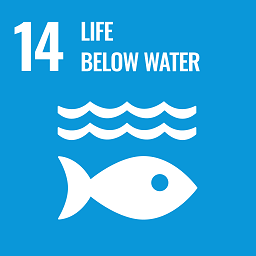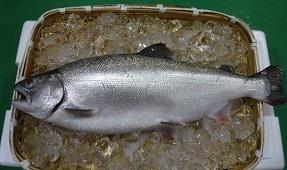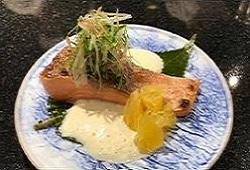Outcome Example of Bio-oriented Technology Research Advancement Institution
Issued on April 15, 2020



Japan's best-quality land-aquacultured brand fish
Cherry salmon is the Yamagata prefecture's official fish and land-aquacultured In Yuza-machi, Yamagata. The farmers dream about growing the cherry salmon as Japan's best-quality brand salmon and exporting it overseas. Expectations are growing up for the advent of a new local industry in Yamagata.
Circulation and filtration of seawater aiming zero-emission
A huge tent-type land aquaculture facility (about 450 m2) is situated in Fukura, Yuza-machi, facing the Sea of Japan (Image 1). There are two round-shaped aquariums (a capacity of 5 tons, a diameter of 2.5 m and a depth of 1 m) in the tent, where silvery white-colored cherry salmons are lively swimming.
It is an industry-government-academia joint research project team of the land-aquaculture of cherry salmons comprising seven institutes, including Maruha Nichiro Corporation, Yamagata Prefecture Agriculture, Forestry and Fisheries Department, KITZ Corporation, and Japan Fisheries Research and Education Agency.
In these two aquariums, 180 juveniles (a body length of 40-50 cm, a bodyweight of about 1.4 kg) one and a half years after hatching are vividly swimming. Adult cherry salmons are scheduled to be raised to the size of 2 kg and harvested in May.
An experimental raising was initiated in September 2017. A filter tank for recycling the seawater for aquaculture, a UV sterilizer, and aquariums for raising cherry salmons are installed with pipes running horizontally and vertically to circulate the seawater in the facility. This technology is called a closed circulation land-aquaculture system. The system automatically controls the water temperature and dissolved oxygen by sensors and enables the user to monitor from anywhere using a smartphone. Mixed feed specific to salmonid is given to the cherry salmons. However, to characterize the local brand's feature, mixing the feed with sake lees and cherries from Yamagata is planned. The feed is automatically and periodically given to the fishes so as not to waste. We aim to the goal of a zero-emission closed circulation land-aquaculture facility.
 |
 |
| Image 1: Cherry salmon raised to the right size for the harvest | Image 2: Sample cherry salmon dish served at a high-class Japanese restaurant in Singapore |
(Images 1,2 are supplied by Maruha Nichiro Corporation)
Air-transported to Singapore
The raised cherry salmons (Image 1) have been served at tasting events in Japan and foreign countries. Cherry salmons raised in this facility have been served as various types of dishes such as sashimi (slices of raw fish), unsalted roasted dish, and dish boiled with soy sauce. They have yielded a high evaluation comparable to natural fish. In May 2019, harvested cherry salmons were air-transported to high-class Japanese, Italian, and French restaurants in Singapore and served at tasting events held there (Image 2). In general, favorable comments like "having a good taste" were obtained; however, there were comments such as "larger-size fishes are preferable" and "too expensive."
In future, further improvement in profitability would be required to foster the aquaculture of cherry salmons as competitive in export. For example, we are required to develop a high-performance farming facility at a low cost, save electricity expenses, and raise as large-sized fish as possible at a high farming density.
ASC Certification for our sustainable aquaculture businesses
This March, the land-aquacultured cherry salmons received the "ASC Certification," one of the Eco Labels on Seafood, given to the environmentally friendly cultivation. It was the first certification for the land-aquacultured salmonid in Japan.
ASC (Aquaculture Stewardship Council) is an international non-profit organization formed by the "World Wildlife Fund" (WWF) and the "Sustainable Trade Initiative" (IDH) in 2010. It examines whether aquaculture businesses operate aquaculture sustainably while preserving the global environment and saving resources and give ASC Certification to companies that meet these requirements. Once the fishes were certificated as "environmentally-friendly aquacultured fish," the businesses are allowed to attach an ecolabel (Image 3) to their products after the conclusion of the license contract separately.

Dreaming of special local product in Yuza
Cherry salmons have been commonly consumed as a cheer at spring festivals in the Shonai district, Yamagata. However, recently, the catch has declined, and there are fewer opportunities to eat them even at spring festivals. The town office and residents in Yuza, where the aquaculture facility is situated, are placing high expectations on the establishment of a new local industry with a hope that if the land-aquaculture business gets on track, and the raised fish could be exported, it can be a unique specialty of Yuza.
Cherry salmon and masu trout
Cherry salmons belong to the family, Salmonidae of the order, salmoniformes. It distributes in the North-West part of the Pacific Ocean. They have a habit of going down into the sea, once grown to adults, swimming around the Sea of Okhotsk and other oceans, and returning to the river where they were born one year after spawning. Whereas fishes that do not go down into seas and stay in rivers throughout life are called masu trout.
Project name
Innovative technology creation promotion project through the field of "knowledge" integration and innovation. (Project of R&D model through the field of "knowledge" integration and innovation)
Project period
FY 2016 to 2020
Title
Development of a next-generation closed circulation land-aquaculture production system using an integrated innovative technique and the creation of Japan's highest-class brand cherry salmon species endemic to Japan
Leading research institute
Maruha Nichiro Corporation
